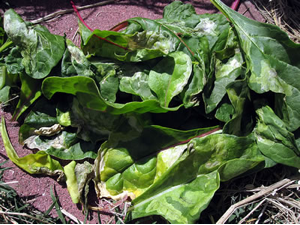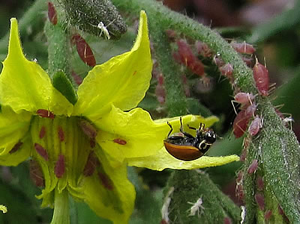by guest blogger Beth Terry
Gardening without buying new plastic…it’s hard enough when you know what you’re doing. But for an inexperienced gardener like me, who thought she could just plant some seeds, water them, and watch the veggies grow, this experience is proving to be a real challenge. This month, I’ve been dealing with bugs and soil issues (even though I bought brand new garden soil!) and weather that feels like March in the middle of July. And since I’m growing this garden organically and without plastic, I can’t just run out and buy a magic potion in a brightly colored spray bottle and call it a day.
(If you’re new to this series, check out my first three posts about buying soil, planting and mulching, and watering without plastic. And check out my blog My Plastic-free Life, to understand the problems with plastic and to find plastic-free alternatives.)
LEAF MINERS
My first unwelcome visitor (which turned out to be the very least of my worries) appeared in the form of little white swirly patterns all across the leaves of my Rainbow Chard. Checking the Internet, I discovered they were made by leaf miner larvae, which tunnel their way through leafy greens, feeding and leaving trails where they’ve been.
OrganicGardening.com says:
“Prevent these hungry critters from depositing their eggs by covering your chard with a floating row cover. Cut away infested leaves. Swiss chard is quick to recover and fast-growing, so any damaged plants should spring up again in no time.”
No row cover for me. I removed all the infested leaves by hand, which turned out to be quite a few by the time I noticed the problem, and have been cutting out affected areas as I see them. The chard is my one super-successful plant this year, and I’m eating it faster than the leaf miners can attack!
APHIDS
Photoshop may have saved my tomato plant. My eyesight is not great, so I had no idea this plant was covered with aphids until I enlarged an image to edit it and pretty much freaked out at what I saw.
I emailed Eric Hurlock from OrganicGardening.com right away. He suggested that instead of using any kind of insecticide, I get rid of them mechanically by blasting with the hose. He also noted the presence of a ladybug on the plant and said that was a good sign. I was all set to go out and buy a container of ladybugs, but Eric directed me to an article explaining why buying ladybugs is not such a good idea:
“The short point here is that purchasing wild-harvested ladybugs, which is almost certainly what you will find at retail outlets, will not do much good for your garden, and it may introduce nonnative species into your local ecosystem. Additionally, purchasing these ladybugs may contribute to the decimation of the wild ladybug populations.”
My final solution was to blast the plant with my old (plastic) garden hose one time, and then maintain the plant by squishing the aphids manually as I see them. It’s pretty gross. And also pretty amazing how easily aphids squish. It’s a wonder their bodies hold together at all. A friend of mine said she’d heard that leaving “dead aphid juice” on the leaves will deter other aphids from coming. I don’t know if that’s true or not, but it seems to be working.
I do have one question, though: I have three different tomato plants, and this plant is the only one with an aphid problem. Could it be that this plant is less healthy for some reason?






please help! how to rid my all natural garden of these little buggies. orangnic ways oh ya i’ve tried a few nothings working trying hard not to give up. thank you miss. bea
I just attended a gardening class at a woman’s home in my city. She’s been gardening in Las Vegas for over two decades (veggies and fruit trees). She uses food grade diatomaceous earth. For spraying on the plants, she uses water as the carrier. That’s the only “pesticide” she uses. She does warn that it will also kill “good bugs” too and even the label states to not spray on flowers as it will kill bees when they collect pollen. However, good bugs are around when they have a food source. I live in the SW where rain is at a minimum, so the residue stays on the plants until I either rinse it off or it rains (rarely happens).
It can help to eliminate ants in the garden; orderly ants may be “farming” aphids on that one plant. See this link for the relationship between ants and aphids: http://science.jrank.org/pages/462/Aphids-Ants-aphids.html
Gardening is a challenge for the novice as well as the master.
Sounds like you are on the correct path – and OrganicGardening always has sound advice – you can’t go wrong! I have found “bug squishing”(and weed pulling) a great stress reducer! Onward organic gardeners!
Just run your fingers gently along the stem of the plant to reduce the population. I do this all the time with aphids on my roses. Now spiders are helping me with that chore! Picking off most bugs is the best way I have found to control insect pests …or tapping them into a container of soapy water. Sadly this year the Japanese beetles are a problem, but this has reduced them. ( I use gloves for these guys!)Soapy water spray would kill aphids too. Organic here in Ottawa Canada for 14 years!
One thing that helps with worms in the broccoli and cauliflower is to keep a flat pan of fresh water near those plants. The wasps which are not aggressive away from the nest, will stop for water and eat the larvae of the worm, or dehydrate the worms by sucking fluid out of them. I use the small discarded roof top satillite dishes for that. Balance them on some rocks, and keep fresh water in them.
Hey team,
That tomato that is being eaten is the unhealthy one of the bunch, its emitting a frequency that bugs adore. The healthy ones emit a different frequency. Find out whats going on at root level. If you have a healthy root system and fertilization method, you will not get bugs. I would recommend a simple compost tea recipe. It will provide the plant with the essential nutrients to build a beautiful root system, if applied as a foliar spray the leaves get a beautiful waxy coat that bugs do not like. Research compost tea, or check out Organicsoutback.com . I will send you a recipe that works wonders.
to control aphids in the future, control the ant hills. I often drown them out if they get too big or i have too many aphids in the garden. Ants farm them, carry them to the plants, then collect the “milk”
Hey, thanks for the advice! I’ll have to remember bug squishing as stress reducer. 🙂
I’m thinking at this point maybe I should just pull out the sick aphid-covered tomato plant. I’m keeping the aphids under control manually, but that plant just looks scrawny and barely has any tomatoes on it in the first place. Maybe it just needs to rest in peace. What do you think?
Chris, please do share your recipe.